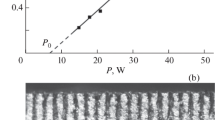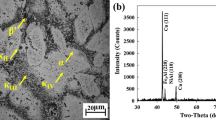Abstract
Dynamic tensile strength and ductility were studied within the range of strain rates from 0.6 to 1.2 × 103 s−1 by applying the split Hopkinson bar method on aluminum bronze samples the surface of which was processed by laser hardening and laser alloying. A number of effects are found: laser surface treatment of the samples significantly reduces the plastic properties of the material and increases the conditional yield stress, the tensile strength values of processed and unprocessed samples are close to each other, oscillations of the yield stress are observed, which can be interpreted as a "yield tooth" phenomenon. Deformation mechanisms explaining these effects were proposed based on the structural heterogeneity of the hardened surface layer and the sample as a whole.

















Similar content being viewed by others
References
ASTM E8 / E8M-21 (2021) Standard Test Methods for Tension Testing of Metallic Materials. ASTM International, West Conshohocken, PA
Shpakov ON (2012) Valve construction from A to Z: terminological dictionary. Energomashkomplect, St. Petersburg–Saratov (in Russian)
McGraw-Hill Dictionary of Scientific & Technical Terms, 6E (2003) The McGraw-Hill Companies Inc, Philadelphia, ISBN 9780070423138
Song B, Sanborn B, Susan D, Johnson K, Dabling J, Carroll J, Brink A, Grutzik S, Kustas A (2019) Correction of specimen strain measurement in Kolsky tension bar experiments on work-hardening materials. Int J Impact Eng 132:103328. https://doi.org/10.1016/j.ijimpeng
Chen W, Song B (2010) Split Hopkinson (Kolsky) bar: design,. testing and application, mechanical engineering series, New York
Stolbovsky AV, Popov VV, Fallakhutdinov RM, Murzinova SA, Shorokhov EV, Zavyalov ZI, Degtyarev AA (2019) Evolution of the structure of tin bronze and copper after dynamic compression by the Kolsky method using a split Hopkinson pressure bar. Diagn Resour Mech Mater Struct 3:43–51. https://doi.org/10.17804/2410-9908.2019.3.041-051
Field JE, Walley SM, Proud WG, Goldrein HT, Siviour CR (2004) Review of experimental techniques for high rate deformation and shock studies. Int J Imp Eng 30:725–775. https://doi.org/10.1016/j.ijimpeng.2004.03.005
Buchar J, Forejt M, Jopek M, Krivalek I (2000) Evaluation of constitutive relations for high strain rate behaviour using the Tailor test. J Phys IV France 10:75–80. https://doi.org/10.1051/jp4:2000913
Jones SE, Drinkard JA, Rule WK, Wilson LL (1998) An elementary theory for the Tailor impact test. Int J Impact Eng 21:1–13. https://doi.org/10.1016/S0734-743X(97)00036-5
Savenkov GG, Meshcheryakov YuI, Barakhtin BK, Lebedeva NV (2014) Deformation and fracture mechanisms and structural changes in coarse-grained cooper under shock-wave loading. J Appl Mech Tech Phys 55:896–903. https://doi.org/10.1134/S0021894414050198
Savenkov GG, Gruzdkov AA, Barakhtin BK, Lebedeva NV (2013) Experimental deformation of effective surface energy density in problems of fracture mechanics. Tech Phys 83:207–212. https://doi.org/10.1134/S1063784213020205
Bragov AM, Balandin VV, Konstantinov AYu, Lomunov AK, Vorobtsov IV, Kuznetsov AV, Savenkov GG (2017) High-rate deformation and spall fracture of some metals. Proced Eng 197:260–269
Panchenko VYa (2009) Laser technologies of metal treatment: modern problems of fundamental researches and applied developments, Physmatlit, Moscow (in Russian)
Kannatey-Asibu E (2009) Principles of laser materials processing, Wiley, Hoboken. ISBN-10: 9780470177983
Dutta Majumdar J, Manna I (2011) Laser material processing. Int Mater Rev 56:341–388. https://doi.org/10.1179/1743280411Y.0000000003
Qu S, An XH, Yang HJ, Huang CX, Yang G, Zang QS, Wang ZG, Wu SD, Zhang ZF (2009) Microstructural evolution and mechanical properties of Cu–Al alloys subjected to equal channel angular pressing. Acta Mater 57:1586–1601. https://doi.org/10.1016/j.actamat.2008.12.002
Tian YZ, Zhao LJ, Park N, Liu R, Zhang P, Zhang ZJ, Shibata A, Zhang ZF, Tsuji N (2016) Revealing the deformation mechanisms of Cu-Al alloys with high strength and good ductility. Acta Mater 110:61–72. https://doi.org/10.1016/j.actamat.2016.03.015
Bragov AM, Lomunov AK, Lamzin DA, Konstantinov AYu (2019) Dispersion correction in split-Hopkinson pressure bar: theoretical and experimental analysis. Continuum Mech Thermodyn. https://doi.org/10.1007/s00161-019-00776-0
Quinn RM, Zhang LH, Cox MJ, Townsend D, Cartwright T, Aldrich-Smith G, Hooper PA, Dear JP (2020) Development and validation of a Hopkinson bar for hazardous materials. Exp Mech 60:1275–1288. https://doi.org/10.1007/s11340-020-00638-w
Bragov AM, Igumnov LA, Konstantinov AYu, Kruszka L, Lamzin DA, Lomunov AK (2021) Methodological aspects of testing brittle materials using the split Hopkinson bar technique. Strain. https://doi.org/10.1111/str.12389
Bragov AM, Lomunov AK (2020) Use of the Kolsky bar method for studying high-rate deformation processes in materials of various physical natures. monograph. Preprint at https://arxiv.org/abs/2008.08151
Cadoni E, Bragov AM, Dotta M, Forni D, Konstantinov A, Lomunov A, Ripamonti A (2011) Mechanical characterization of steel for fastening in a wide range of strain rate. Eng Trans 59(2):101–117
Basalin AV, Bragov AM, Konstantinov AY, Lomunov AK, Zhidkov AV (2021) High strain rate tension experiments features for visco-plastic materials. In: dell'Isola F, Igumnov L (eds) Dynamics, strength of materials and durability in multiscale mechanics. Advanced structured materials, vol. 137, Springer, Cham, pp 191–222. https://link.springer.com/chapter/10.1007/978-3-030-53755-5_13
Bragov AM, Konstantinov AYu, Lomunov AK (2010) Determining the Bauschinger effect using the direct impact technique. Tech Phys Lett 36(8):694–695. https://doi.org/10.1134/S1063785010080043
Davidenkov NN (1929) Dynamic tests of metal. State Publishing House, Moscow-Leningrad (in Russian)
Krishtal MM (2004) Instability and mesoscopic heterogeneity of plastic deformation (analytical review). Part I. Phenomenology of tooth flow a physical mesomechanics intermittent fluidity. Phys Mesomech 7(5–6):5–29
Cottrell AH (1980) Dislocations in metals: the Birmingham school, 1945–1955. Proc R Soc A. https://doi.org/10.1098/rspa.1980.0071
Physical Metallurgy, RW Cahn and P Haasen, Eds (1965) North-Holland, Amsterdam. https://www.elsevier.com/books/physical-metallurgy/cahn/978-0-444-89875-3
Honeycombe RWK (1968) The plastic deformation of metals, London, Edward Arnold Ltd. https://archive.org/details/plasticdeformati0000hone/page/n5/mode/2up
Meshcheryakov YuI, Savenkov GG (2001) Oscillation of the plastic wave front under high-rate loading. J Appl Mech Tech Phys 42:1023–1028. https://doi.org/10.1023/A:1012522029329
Acknowledgements
The dynamic experiments were supported by the Ministry of Science and Higher Education of the Russian Federation (task 0729-2020-0054). The investigation of mechanical properties of bronze after laser processing was carried out with the financial support of the Russian Science Foundation (Grant 21-19-00283).
Author information
Authors and Affiliations
Corresponding author
Additional information
Publisher's Note
Springer Nature remains neutral with regard to jurisdictional claims in published maps and institutional affiliations.
Rights and permissions
About this article
Cite this article
Bragov, A.M., Konstantinov, A.Y., Lomunov, A.K. et al. Features of Dynamic Deformation and Failure of Aluminum Bronze Processed by Laser Surface Treatment. J. dynamic behavior mater. 8, 122–136 (2022). https://doi.org/10.1007/s40870-021-00326-3
Received:
Accepted:
Published:
Issue Date:
DOI: https://doi.org/10.1007/s40870-021-00326-3




